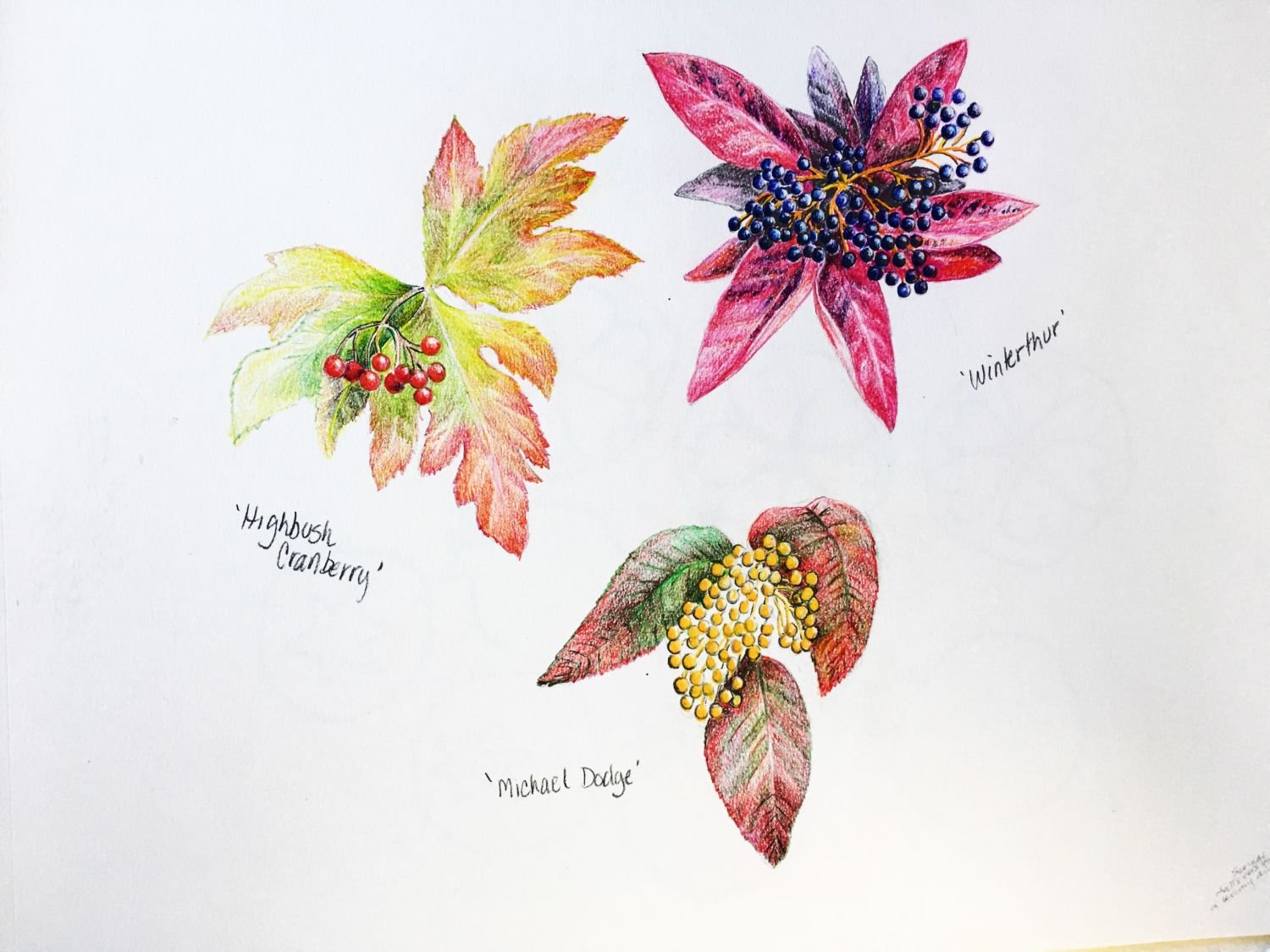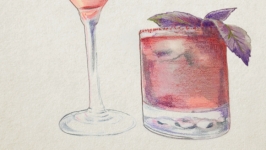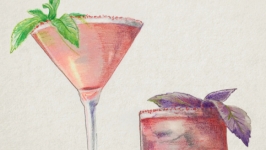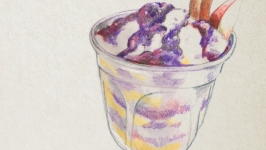A Berry Festive Fall
Some plants are showy in spring or summer while others seem to strut their best stuff when most northeastern plants are heading into dormancy. The shrubs featured here are four-season pleasers but their berries and dramatic leaf colors—not to mention their appeal as potential desserts—make them stars of the fall season.
Something to Swallow (Chokeberries)
Traditionally, the fruit of the aronia bush (Aronia melanocarpa) was used by various Native American peoples to treat colds, preserve meat or create a sauce served with fry bread. This plant's popularity surged again about a decade or two ago as excitement built around antioxidant qualities of dark blue and purple fruites.
Its healthful properties rank up there with the açaí berry and have been noted to exceed blueberry's benefits. Commercial production has come nowhere close to blueberries but frozen or dried aroniz berries can be found if you want to try them.
They may be considered a superfruit, but there’s a reason they are commonly called chokeberries. The dark, tart berries will twist your tongue if you eat them fresh, and they are not a quick favorite for birds, either. Berries the size of blueberries ripen in fall, just as the foliage is turning flame-colored. In spring you are treated to a haze of delicate white flowers.
I favor making a sauce or jelly from chokeberries to serve with pancakes, corn cakes, fry bread, cheese or ice cream desserts. They are also a delicious addition to muffins or scones. Like the tang that rhubarb adds to a strawberry pie, aronias add a nice dimension to an autumn apple crisp.
Aronia melanocarpa ‘Black Chokeberry’
Zone: 3–8
Height: 3–6 feet
Spread: 3–6 feet
Foliage: green turning orange and red in fall
Flowers: white
Berries: black
Edible? yes
For the Birds (Red Osier Dogwood)
Cornus sericea is plain-looking during summer months, but in winter the red osier dogwood’s leafless bright red stems march boldly across a hillside making a striking statement against a drab December backdrop. The common name “osier” derives from the branch’s similarity to willow canes and they are often used decoratively in basket weaving.
In spring, the bright red stems start to darken, but perky white flowers trim the branches as light green leaves emerge. Small creamy-white berries appear sometime around July through September and as autumn approaches the leaves turn reddish purple.
Given their spreading habit, these shrubs form a nice thicket. They don’t mind pruning and aren’t too fussy about where they put their roots. For birds, they offer a trifecta of benefits with insect-attracting flowers in spring, a nice nesting spot during summer and fruit with high fat content to prepare for migrations in fall.
People can also eat these tart berries, and some Native Americans mixed the inner bark with tobacco for smoking.
Cornus sericea ‘Red Osier Dogwood’
Zone: 3–8
Height: 6–9 feet
Spread: 8–12 feet
Foliage: green turning red and purplish
red in fall with notable bright red branches
Flowers: white
Berries: creamy white
Edible? yes
It’s All in the Name (Highbush Cranberry)
There are over 150 species of Viburnum so it is easy to find a good fit for your yard. Many are well suited to Western New York’s climate, including michael dodge and winterthur, and some are even native. I chose to feature the highbush
cranberry because the berries are similar in appearance and taste to the frozen cranberries we love to buy in the store (lowbush, Vaccinium macrocarpon), but acquiring the correct shrub for eating can be confusing.
There are highbush cranberries that are fairly tasty when processed as condiments or juice. And then there are those that taste really awful. The tasty ones, native to North America, are Viburnum opulus var. americanum. Sometimes they are referred to by an older name, Viburnum trilobum. The not-so-tasty ones hail from Europe and have the Latin name Viburnum opulus (minus the americanum).
With enthusiasm we carefully placed our order for what we thought was the yummy version. However we now have a field of bushes that even the deer won’t touch. Someone forgot the “americanum” part. With their bright red berries, they are beautiful—even through winter. Birds tend to leave the berries (both American and European) for later,
when there are fewer choice bits around. Their spring blossoms attract insects that provide a good source of protein for nesting birds.
Like other tart produce, this fruit finds its way onto our plate through the addition of sweeteners. Highbush cranberries can be transformed into lovely jams, jellies and juices, and you might be thrilled to use them for a traditional-looking cranberry sauce or pie for the holidays.
Viburnum opulus var. americanum ‘Highbush Cranberry’
Zone: 2–7
Height: 8–10 feet
Spread: 8–10 feet
Foliage: green turning red in fall
Flowers: white
Berries: bright red
Edible? yes
Friend, Not Foe (Staghorn Sumac)
It is easy to think of the staghorn sumac as a weed or undesirable—especially because once it takes root it can easily spread from one tree to a grove in a matter of a few years. However, it does provide a few blessings as well as visual drama when incorporated purposefully into a landscape. Native to eastern North America, you often see it around
these parts cropping up on roadsides and next to abandoned barns.
Though many believe the staghorn sumac to be poisonous, it is not, although it may be an allergen to some. Poison sumac (Toxicodendron vernix) and staghorn sumac (Rhus typhina) are both in the Anacardiaceae plant family that also happens to include cashew, mango and pistachio. Poison ivy and poison sumac share the genus Toxicodendron but staghorn falls into the Rhus genus.
While the leaves of staghorn and poison sumac look similar, their fall berries do not, so the distinction can be made easily. Staghorn berries form in upright red spikes or cones while poison sumac’s berries are whitish and hang down. Both can have light-colored flowers.
Although the spiky, hairy cone of berries may look daunting, it yields a refreshing lemony-tasting pink tea when brewed in hot water. Just add honey! The brew can also be made into a jelly. For a more exotic twist the dried and processed berries form a key ingredient in the Mediterranean spice mix called za’atar, which also typically includes oregano,
thyme, marjoram and sesame seeds. Depending on the region where it is created the version of za’atar may or may not include sumac.
If you are able to stand back a bit and view this tree as something other than a weed, you will see its delicate, graceful structure and may find that you appreciate its dramatic fall display of fiery colors.












